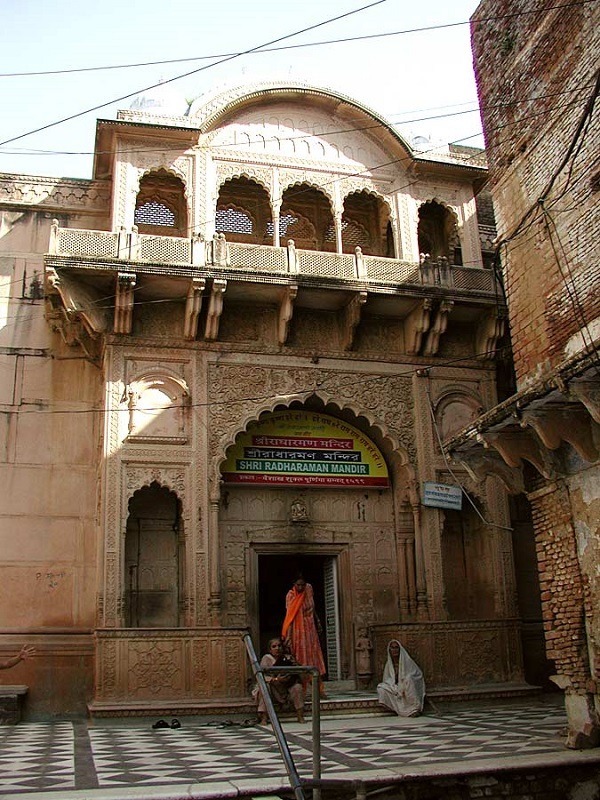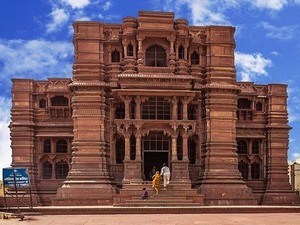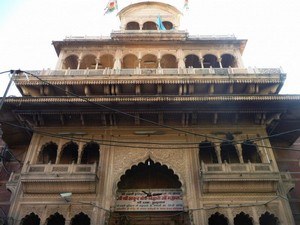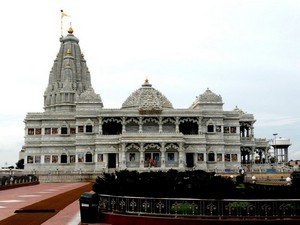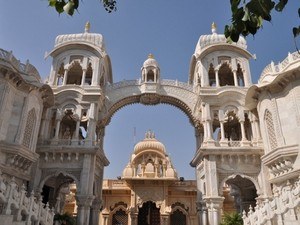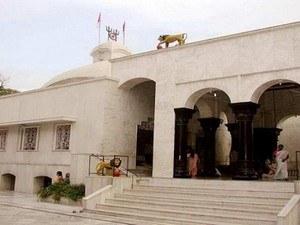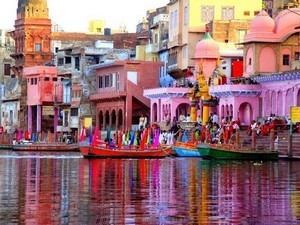Radha Ramana Temple, Vrindavan - Timings, Festivals, History, Darshan, Pooja Timings
Photo Credit: Flickr
 #7 of 14 Places to Visit in Vrindavan
#7 of 14 Places to Visit in Vrindavan
 Distance (From Vrindavan Railway Station): 2 Kms
Distance (From Vrindavan Railway Station): 2 Kms
 Trip Duration (Including Travel): 1 Hour
Trip Duration (Including Travel): 1 Hour
 Transportation Options: Cab / Auto
Transportation Options: Cab / Auto
 Travel Tips: None
Travel Tips: None
About Radha Ramana Temple
At a distance of 2 Km from Vrindavan Railway Station, Sri Radha Ramana Temple is a popular Hindu temple situated in the holy land of Vrindavan, Uttar Pradesh. this temple is dedicated to Lord Krishna as Radha Ramana means lover of Radha Ji. It is one among the 7 temples of Thakur of Vrindavan including Sri Radhavallabh ji, Sri Bankey Bihari Ji, Sri Govind Dev ji and three others, and among the must-include places in the Vrindavan packages. The temple is renowned for housing the original Shaligram deity of Krishna. This idol is self-manifested from Shaligram Shila, and is characterized by a mystical smile upon his face.
History of Radha Ramana Temple
The Radha Raman Temple in Vrinvadan was established in the year 1542 by Gopala Bhatta Goswami, one of the six Goswamis of Vrindavan who followed the principles of Sri Chaitanya Mahaprabhu strictly. The temple is exquisitely crafted and one of the most revered temples in Vrindavan, especially by the followers of Gaudiya Vaishnavism. It houses the original shaligram idol of Lord Krishna. The temple was renovated in the year 1826 by Shah Behari Lallji.
Mythology of Radha Ramana Temple
Gopala Bhatta Goswami, the founder of this temple, arrived in Vrindavan at the age of 30. After the departure of Chaitanya Mahaprabhu, Gopala Bhatta Goswami experienced a profound sense of separation from the Lord. To ease his devotee's solitude, the Lord appeared in Gopala Bhatta's dream and instructed him to travel to Nepal to attain His darshan. Gopala Bhatta Swami journeyed to Nepal and bathed in the renowned Kali Gandaki River. To his astonishment, several Shaligrama Shilas entered his water pot after he dipped it into the river. He attempted to return them to the river, but they persistently re-entered the pot. Ultimately, he collected a total of 12 Shaligram Shilas and brought them back with him.
After offering naivedya to his Shaligrama Shilas on the day of Purnima, Gopala Bhatta laid them to rest in the evening, covering them with a wicker basket before he went to rest. The following morning, when he uncovered them to perform puja, he discovered only 11 Shilas and a deity of Lord Krishna playing the flute. Essentially, one of the Shilas had self-manifested into a deity, which became known as Radha Raman. This narrative of the appearance of Radha Raman and the original Shila is enshrined in this temple.
Architecture of Radha Ramana Temple
The architectural design of the Radha Ramana Temple exemplifies the modern Hindu architectural style. The main deity is a self-manifested figure derived from a shaligram shila, measuring approximately 30 cm in height and adorned with a mystical smile. Although there is no representation of Radharani within this temple, a crown is placed beside Krishna to symbolize her presence. Adjacent to the Radha Raman Temple, within the same compound, lies the Samadhi of Gopala Bhatta. Additionally, it is believed that the Radha Raman Temple houses the rare garments worn by guru Chaitanya Mahaprabhu.
Festivals of Radha Ramana Temple
The Radha Raman Temple serves as a significant hub for the observance of various Hindu festivals, especially those associated with Lord Krishna and Radha, such as Janmashtami, which commemorates the birth of Lord Krishna, and Radhashtami, celebrating the birth of Radha. These festivals feature special prayers, ceremonies, and events that draw a considerable number of devotees. Holi, known as the festival of colors, is celebrated with lively colors and cultural performances. Additionally, the temple observes other Hindu festivals, including Ram Navami, Chandan Yatra, Jhulan Yatra and Sharad Purnima, with great enthusiasm.
Dress Code & Other Restrictions of Radha Ramana Temple
Radha Raman Temple in Vrindavan has a dress code that mandates visitors to don modest and traditional clothing. Men are expected to wear long pants, or dhotis along with shirts or kurtas, whereas women should opt for sarees, salwar kameez, or other forms of Indian attire that adequately cover the shoulders and knees. It is advisable to refrain from wearing Western garments such as shorts, skirts, and sleeveless tops.
Generally, non-Hindus are welcome to visit Radha Raman Temple as it is a place of international spiritual interest and welcomes people from all faiths to experience the cultural and spiritual atmosphere.
Radha Ramana Temple Timings
Monday: 8 AM - 12:30 PM & 6 PM - 8 PM
Tuesday: 8 AM - 12:30 PM & 6 PM - 8 PM
Wednesday: 8 AM - 12:30 PM & 6 PM - 8 PM
Thursday: 8 AM - 12:30 PM & 6 PM - 8 PM
Friday: 8 AM - 12:30 PM & 6 PM - 8 PM
Saturday: 8 AM - 12:30 PM & 6 PM - 8 PM
Sunday: 8 AM - 12:30 PM & 6 PM - 8 PM
Radha Ramana Temple Entry Fee
Entry is Free
Best Time to Visit Radha Ramana Temple
The best time to visit Radha Ramana Temple in Vrindavan is from October to March. During this period, the climate is pleasant, making it comfortable for visitors to explore the temple and participate in the festivities. For individuals wishing to experience the temple at its most spiritually enriching, it is recommended to schedule your visit during the Janmashtami festival, which commemorates the birth of Lord Krishna and generally takes place in August/September. Another favorable occasion to visit the temple is Holi, the festival of colors, which typically happens in March. Nevertheless, it is important to note that the town experiences a surge of tourists during these festivals, so one should be ready for the bustling crowds. Vrindavan endures extremely hot summers and heavy monsoons, rendering those months less suitable for travel and exploration.
How to Reach Radha Ramana Temple
Agra Airport is the closest airport, which is 70 Km away from Vrindavan. Vrindavan has a Railway Station but Mathura is the major railhead, which is about 13 Km away. Mathura Junction Railway Station is a major rail head with regular train services to Delhi, Mumbai, Ahmedabad, Hyderabad, Pondicherry, Vizag, Dehradun, Chandigarh, Trivandrum, Shirdi, Jammu Tawi, Chennai, Hubli, Goa, Patna, Lucknow, Bangalore and Chhattisgarh. Vrindavan is also well connected by road with Mathura, Agra, Jaipur, Lucknow, Delhi, Indore and Allahabad. One can reach Radha Ramana Temple by hiring a cab, or an auto-rickshaw from all parts of Vrindavan.



